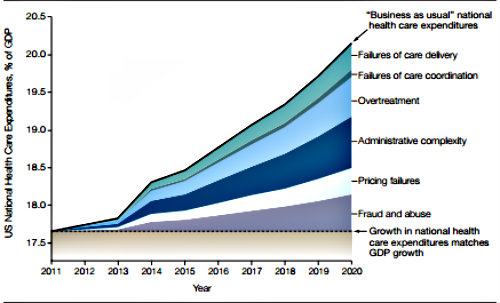As we enter 2014, the topic of health care costs continues to be a major topic of conversation in the media and among policy makers. The topic is complex and can be spun in different ways.
You may have seen the recent news about how growth in health care spending in the United States has remained low for four consecutive years, for which the White House would like to take some credit. Or you may have seen news reports about how Medicaid expansion in Oregon led to higher emergency department use (and therefore higher costs), which is used by some to argue against the Affordable Care Act. The bottom line is that understanding health care costs is a complex task.
Clearly, the issue of out-of-control U.S. health care costs is of crucial importance and has been a serious challenge to increasing funding for other needs, such as improving infrastructure and education. It is also one in which the general public, pundits, and politicians look for simple, single reasons and matching solutions, e.g., obesity/calorie designations on menus; malpractice insurance/tort reform, too much government involvement/more private sector competition, etc.
Finding an agreed-upon “solution” is further complicated by strong partisan differences in the country about how we can deliver high-quality care at lower costs and the clear fact that there will be winners and losers in any cost-reduction program.
My view, which mirrors that of John Green (he has made a video that has gone viral on YouTube, with more than 4.8 million viewings) is that health care costs are high in the U.S. because everything costs more. And they are higher in the U.S. than in other countries, and higher than they need or should be for several complicated reasons.
http://youtu.be/qSjGouBmo0M
In his video, Green, a bestselling author and enormously popular YouTube video blogger, or vlogger, tries to break these reasons down. He argues that we pay more for prescription drugs than other countries (probably $100 billion more) and for surgical procedures and equipment such as hip and knee replacements. Administrative costs, especially those associated with insurance, are also higher and growing. Here Green estimates we pay about $90 billion more. Doctors and nurses also earn higher salaries in the U.S. compared to most European countries.
In the U.S., we also pay more for those who don’t have health care by paying for costly emergency room care or paying monies to low-income people who have gone broke because they didn’t have health insurance and were forced to pay out-of-pocket.
Perhaps most important, we don’t have a central authority to negotiate lower prices for health care costs as is done in many other countries. Because there is no central effort to lower costs—and little transparency and no real competition that would actually reduce costs—the price of health care services and products continues to rise. Again, Green estimates that the extra costs here may be in the neighborhood of $500 billion.
Each of these components plays a role in the health care cost equation. None of it can be boiled down to a single, simple explanation. And therefore, as former Medicare administrator Don Berwick and RAND assistant policy analyst Andrew Hackbarth have argued, there will be no single, simple solution to the health care cost problem. Rather, there must be multiple “slices” removed to achieve better outcomes at a lower per-person cost. (For more information, read “Don Berwick on cutting health-care costs” on the Washington Post’s WonkBlog.)
We and our grantees will work to do our part to overcome failures in care delivery, care coordination, and overtreatment, but the country must recognize the complex nature of rising health care costs and work together to tackle the problem’s many components.

